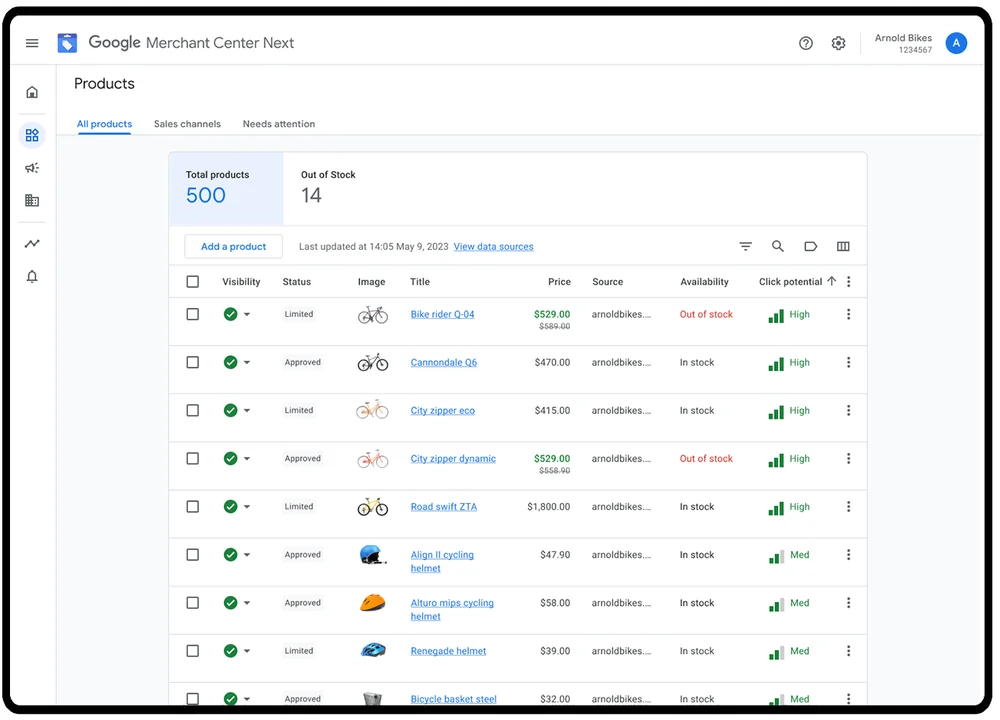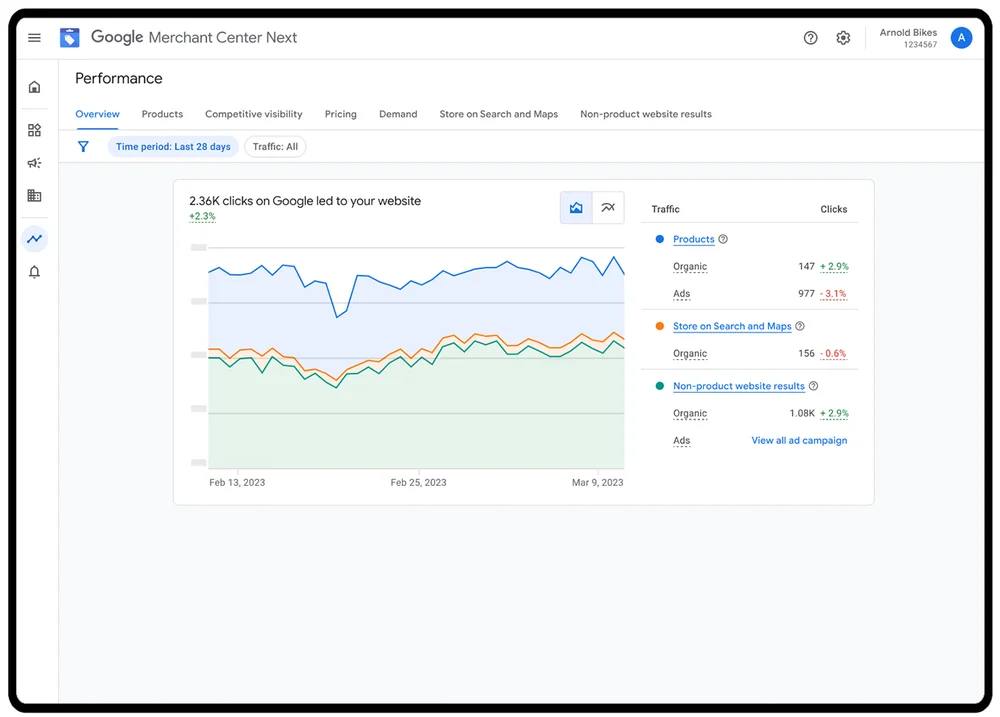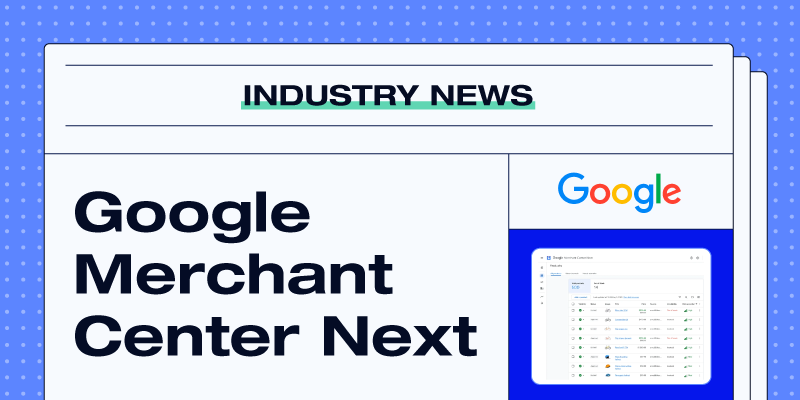What is Google Merchant Center Next?
In May 2023, Google introduced the newest version of Merchant Center called Merchant Center Next at Google Marketing Live. Google speakers walked the audience through major changes to the Google advertising experience fueled by new AI tools across its suite of platforms, including Google Merchant Center and Google Ads.
Google Merchant Center Next (GMC Next) is in the process of being rolled out to new merchants, with existing merchants following soon. The rollout is scheduled to be completed in 2024.
Merchants can opt in—or accept an invite to GMC Next—but at the moment, GMC Next doesn’t have full feature parity with what Google calls the classic experience of Google Merchant Center, which we refer to here as GMC Classic.
If a merchant activates GMC Next and finds it limiting, they can revert back to GMC Classic, but will not be allowed to opt back into GMC Next until Google forcibly migrates them to the platform again.
Google has indicated that Merchant Center Next is meant to be a more simplified experience than its predecessor and will make ecommerce more accessible to smaller merchants.
The new tools in GMC Next can benefit businesses with smaller product catalogs, but they don’t address, or aren’t built to scale, key feed management processes.
Keep reading for more in-depth details about the platform and its limitations. If you’re looking for quicker answers about Merchant Center Next, check out the FAQ section farther down.
What’s new in Google Merchant Center Next?

Source: Google
New feature: Automatically create product feeds from your website
Google can now crawl your website to automatically detect and import product data like titles, descriptions, sizes, prices, and images directly to Google Merchant Center. This automates the process of building your first product feed and can be a good starting point for new merchants.
Feed limitations: Web crawling doesn’t produce optimized data
While the ability to scrape information from your website is handy, the feed you generate isn’t optimized for Search or Shopping campaigns. Google has specific listing requirements and best practices you should follow to improve your campaign performance, and chances are that your site data isn’t there yet.
Merchants also currently lack the option to upload a supplemental feed to enhance the quality of their listings.
New feature: Edit product data within Google Merchant Center
You can now directly edit product details within the Merchant Center Next interface, rather than only having options to upload or delete products as before. This makes it easier to change attributes like titles, descriptions, brand names, image_URLs, and more. However, you can only make edits on a product-by-product basis.
Feed limitations: This process isn’t scalable
Since Google Merchant Center Next only allows you to edit product data directly from the dashboard one SKU at a time, using this platform isn’t currently feasible for businesses with large product catalogs or who want to list on multiple channels. There’s also no efficient way to create robust optimization rules that update your catalog on an ongoing basis.
Merchants need a robust feed management platform to automate and optimize their listings for each shopping destination. Even if you’re only selling on Google, your feeds must be optimized for performance.
“I cannot stress enough—if you are sending the same blanket product data to every single channel, you’re not optimized for success. There’s no way you are getting the best return that you should on all your ads, social, and marketplace channels. It’s just not possible.”
New feature: Edit images in Product Studio
Product Studio is a new product visual editing tool coming to Merchant Center Next that allows merchants to enhance and edit product images quickly.
Source: Google
Here’s what you need to know about Product Studio:
- Merchants can use Product Studio to manage, create, and upload product content.
- Product Studio enables retailers to edit images and transform them into lifestyle images
- Using AI, product backgrounds can be removed, images can be enlarged, and new scenes can be generated (like adding a stone platform or beach scene to your product image)
- These images can be added to or replace existing product images and automatically update in product feeds across Google channels, or be downloaded for other channels
- The feature will be available in the U.S. later this year
New feature: Click potential metric
A new metric called “click potential” calculates the potential for users to click on your product listing ads. A product’s click potential estimates its performance potential compared to your highest-performing products. Click potential is calculated based on past traffic, product data, and demand. Products are categorized as either having “high,” “medium,” or “low” click potentials.
Feed limitations: Click potential doesn’t directly address poorly optimized listings
In addition to A/B testing your product titles, descriptions, and other attributes, you also need to ensure your team is up-to-date on Google’s best practices and consistently implement them in order to improve listing performance.
Strategic merchants need a way to test changes to their product feeds and dynamically segment products into groups for different bid strategies.
Feedonomics allows merchants to import SKU-level performance data like clicks, conversions, profit margins, ROAS, and CPA, and then create custom labels around those groups for performance-based bidding.
New feature: Design and layout changes
The overall design is cleaner and intended to provide a better-organized and more user-friendly experience, akin to previous Google Ads interface upgrades. However, it is missing some important features from the last version.

Source: Google
- All insights reports will be accessible via the Performance tab.
- Several tabs have changed their location, and some features are currently left out. For example, the “Growth” tab is missing and “Business details” have moved.
- The “Diagnostics” tab underneath the “Products” tab only shows the current status of product approvals without the historical view.
- It’s also missing a way to see your product feed or raw data feed. The “Feeds” tab from the existing Google Merchant Center is not in Merchant Center Next, but we expect this to change by the final rollout.
Feed limitations: No data governance safeguards
With the diagnostics tab missing historical data, ongoing issues may be harder to track. Google frequently updates its listing requirements and best practices, so having a feed management platform with data governance safeguards that trigger alerts and stop problem-causing exports is essential.
Product import thresholds, automated retries for unsuccessful imports or exports, and alerts that detect upstream data issues are all examples of safeguards that aren’t available in Google Merchant Center Next.
“What happens if your listings were disapproved and weren’t updated for a day? What would that do for you? What if it was Cyber Monday or Black Friday and you were down for four days and you couldn’t figure out why your listings weren’t up? How would that hurt your business? How many hundreds of thousands of dollars would potentially be lost?”
New feature: Ways to import and add products
You can import product data from your online store, ecommerce platform, feed file, or a Google Sheets template. You can also add products manually one by one. Your feed file can be hosted from a URL and Google will retrieve product data from it every 24 hours, or you can reupload your file at any time.
Feed limitations: No syndication and requires manual synchronization
Google Merchant Center Next limits your feed exports to Google services, so if you’re looking to run an omnichannel business and integrate your strategies together, you need a solution that can manage multiple feeds under one roof.
Keeping track of your assortment and inventory across channels can be a manual process, especially if your catalog frequently evolves. A feed management platform solves this problem with automated synchronization and syndication features that keep your product data up-to-date everywhere you sell.
“It can be really hard if you’re running your business in silos or if you have one person trying to manage listings across seven marketplaces, five ad channels, and social commerce with totally separate information tools. It’s really hard to take all these different pieces of information and funnel into all these different channels to ensure you’re not overselling and not having any of these issues and that your listings are always updated.”
New feature: Easier to add support information
According to Google, Merchant Center Next allows retailers to quickly provide their customer service information within Merchant Center. On the Home page, you can now “Add info,” which includes the following customer support details:
- Telephone number
- Email address
- Web page
- Live chat or chatbot availability
This allows Google to show your customer support information to shoppers when they’re searching for it.
The only feed management platform you’ll ever need
To address Google Merchant Center Next’s limitations, you need a robust feed management solution.
With Feedonomics, you can streamline and scale advertising on Google Ads in addition to hundreds of other paid search, social media, and affiliate channels. Your source data can also be prepared and syndicated on marketplaces for a true omnichannel strategy.
Our fully managed solution streamlines product listing, feed optimization, data protection, and more to maximize your performance everywhere you sell.
Google Merchant Center Next FAQ
Who benefits from the new Google Merchant Center Next features?
The new web crawling features may help smaller merchants quickly create their first Google product feeds. Other businesses may benefit from the ability to quickly edit product images in Product Studio.
However, due to the limitations of the features, merchants who want to scale and optimize their catalog will still look to feed management platforms for the functionality they need.
How do I check my product feed in Google Merchant Center Next?
Currently, there is no way to check your product data feed in Google Merchant Center Next.
Why can’t I see my “click potential” in Google Merchant Center Next?
If no click potential is shown, that means Google is still estimating the click potential. Check back later to find the click potential for this product.
If you can’t see the metric at all, you may still be missing access to Google Merchant Center Next, as it’s still being rolled out to merchants. The full rollout is expected to be completed by the end of 2024.
How can I improve my Google listing performance?
We wrote a three-part guide to help you do exactly that.
How do I resolve a Google Merchant Center Next account suspension?
If you’ve received the dreaded Google Merchant Center account suspension for “misrepresentation of self or product,” check out this step-by-step guide to resolve it.
Learn how Feedonomics can improve your Google Shopping feeds.

With its leading data feed management platform, Feedonomics helps brands, retailers, and agencies optimize and list products on hundreds of shopping destinations around the world. Learn more about our full-service solutions for advertising channels and marketplaces.


